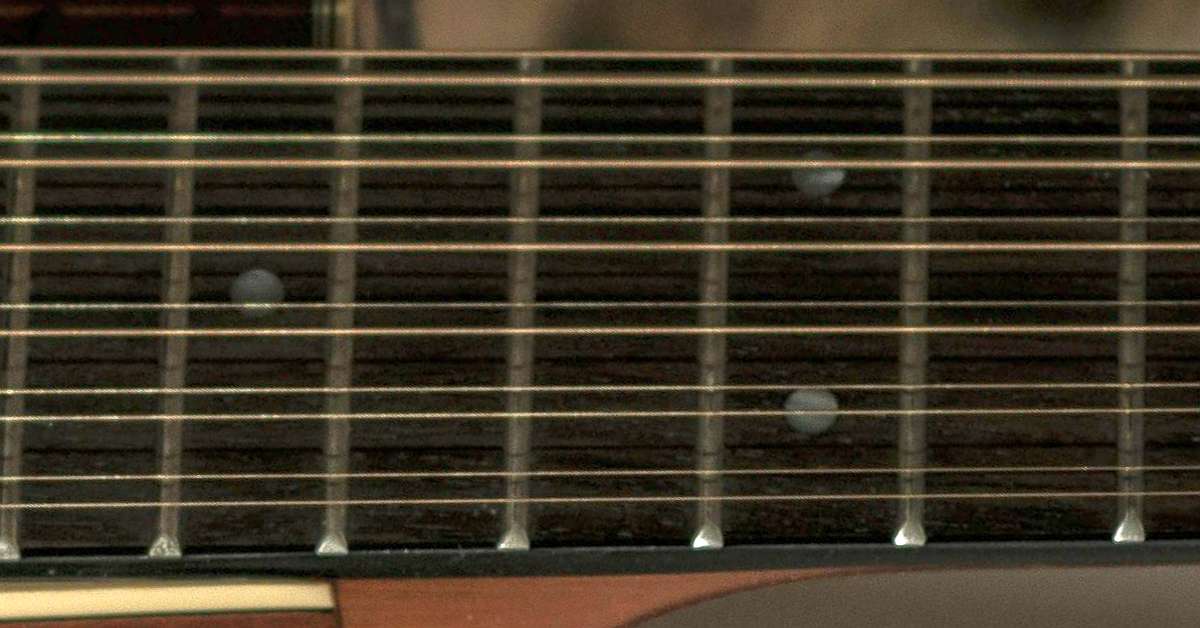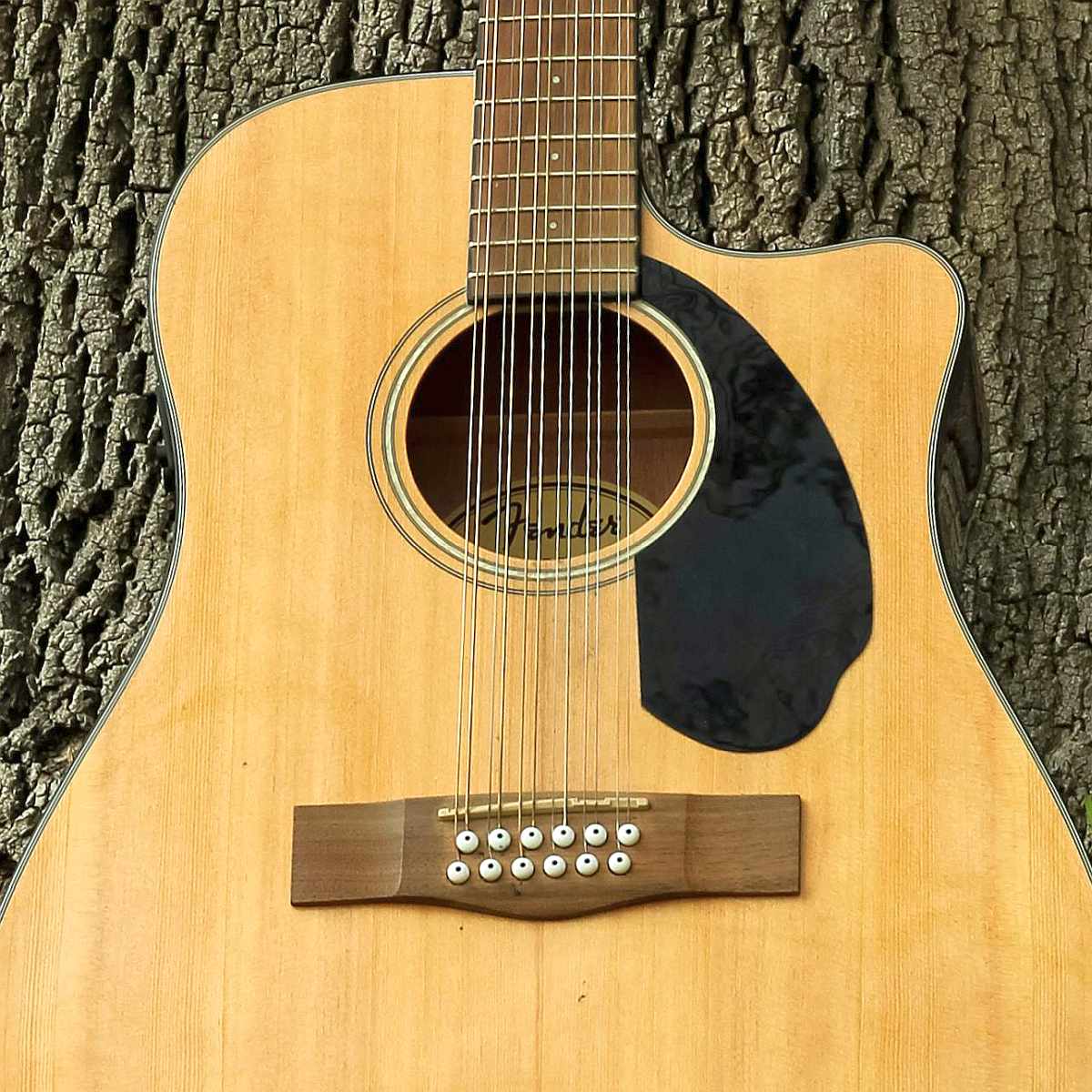Want the lush sound of a 12-string guitar, but you happen to play fingerstyle? Rest assured; it's possible, and this guide shows you how.
The first time I ever held a 12-string guitar was when I was about 10. It was at the music store where I took guitar lessons. When I first picked up the 12-string, I remember distinctly thinking, man, this instrument sure is heavy!
And I was also fascinated by the presence of strings on the 12-string guitar that were tuned to notes that didn't exist as open strings on my 6 string axe.
At the time, I was content to strum a couple of chords. But only until much later on did I realize that you could successfully play fingerstyle guitar on what seemed at the time to be a beast of an instrument.
So, if you're wondering how this is all possible, I'll show you what a 12-string actually is, how its courses are arranged and tuned, practical setup tips and examples specifically for fingerpickers.
This article contains affiliate links. When you purchase using an affiliate link, I may earn a small commission without any extra cost to you.
What's a 12-string guitar?
A 12-string guitar has six pairs of strings, called courses, played together as if each pair were a single string. The doubled strings create a natural chorus effect, which means you'll hear more overtones than you would with a normal six-string guitar.
Some guitarists, like Korean fingerstyle virtuoso Sungha Jung, describe it as sounding like two instruments playing simultaneously.
Courses
Each of the six courses of the acoustic 12-string guitar consist of two strings placed close together. When you pluck a course you sound two strings at once, which gives that characteristic shimmering “big” tone.

How are strings tuned on a 12-string guitar?
Standard tuning for a 12-string matches a 6-string in pitch for the primary string in each course, with the smaller courses either tuned an octave above (on the four lower courses) or in unison (on the two highest courses).
In other words, the lower four strings (E, A, D, G) pair a standard pitch string with a thinner string tuned one octave higher; the top two courses (B and high E) are simply doubled and tuned in unison.
Alternate tuning on a 12 string
You can of course, tune the courses to whatever you want. Mexican Requinto style or requinto tuning involves using two pairs of identical string sets instead of the octave courses. This moves the guitar away from the more ethereal sound of the octave courses to a sharper, more prominent or booming sound due to the doubled bass sets.
This sounds cool, but unless you are tuning down the guitar a whole step (like in La Diabla—see below), the extra string tension caused by the double set of heavy bass strings could cause problems to your instrument. Specifically, the extra pulling force on the neck and bridge could severely, and possibly permanently, damage the guitar.
What are the best strings for 12-string fingerstyle?
Stick to light gauge sets for 12 string fingerstyle for reduced tension. This will make it easier not only on the instrument but also for yourself. Use two sets of extra-light six-string sets (.010–.047) or a dedicated 12-string set for a standard tuning setup.
Why play fingerstyle on a 12-string?
When you play fingerstyle on a 12-string, you're not just attempting to get more volume. The extra strings, especially when tuned an octave higher unlock an effect called phantom tones, which is an effect known to Indian folk players but somewhat unknown to modern fingerstyle guitarists. Essentially, the overtones create a shimmering effect, much like with cascading harmonics.
How to fingerpick on a 12-string
Technique is similar to 6-string fingerpicking, but the doubled strings require slightly different attack and considerably more force to get proper sound out of the guitar. Legendary guitarist Pete Seeger notably used finger picks for his 12 string guitar which considerably improved the volume.
For easier playing, consider adjusting the truss rod to manage the neck relief, which in turn affects the action. If you’re not comfortable doing this yourself, consider taking your guitar to a skilled technician. It’s worth it for the comfort that you’ll gain.
Remember that the octave courses will sound terrible if not perfectly tuned. If you want to use unison or requinto tuning, consider tuning a whole step down, like we'll see just below.
Songs That Use a 12-String Guitar Fingerstyle
12-string fingerstyle appears most often alongside the 6 string guitar and adds character to solo intros, accompaniment parts, and studio arrangements. You'll hear this line at the beginning of La Diabla by Xavi played on a 12 string guitar tuned a whole step down.
d|-4--4-4--4--4--4-|--16--16-16--16--16--16--16--| A|-5--5-5--5--5--5-|--17--17-17--17--17--17--17--| F|-----------------|-----------------------------| C|-----------------|-----------------------------| G|-----------------|-----------------------------| D|-----------------|-----------------------------|
What's the best acoustic guitar for 12-string fingerpicking?
When selecting a 12-string acoustic guitar specifically for fingerstyle, choose an instrument with an internal bracing pattern and neck that handles extra tension while letting the notes ring out without too much force required. Solid-top dreadnoughts with a grand auditorium or concert body shape are you want (big, bright, or balanced).
Fingerstyle on a 12-string is rewarding: the doubled courses create a lush harmonic bed that makes solo arrangements sound huge. The tradeoffs are extra setup care, a bit more physical demand, and the need to refine your technique. With the right setup and understanding of what's required, a 12-string becomes a magnificent fingerstyle instrument.



